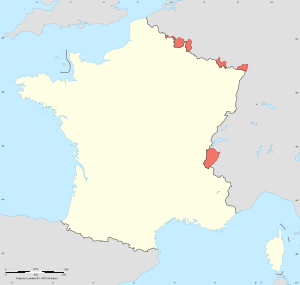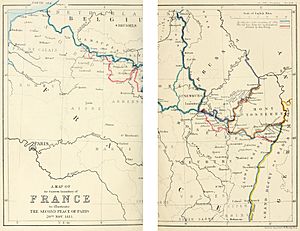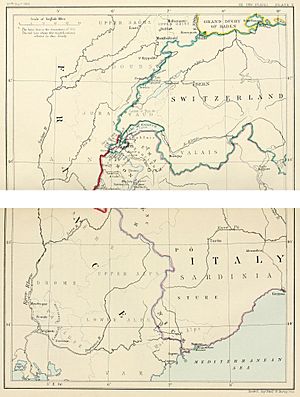Treaty of Paris (1815) facts for kids

Zone of occupation of France from June 1815 to November 1818.
The French territory where the occupation came into force: British occupation zone Prussian occupation zone Russian occupation zone Baden and Saxony occupation zone Bavarian occupation zone Hesse and Württemberg occupation zone Swiss occupation zone Sardinian occupation zone Austrian occupation zone |
|
| Type | Bilateral treaty |
|---|---|
| Signed | 20 November 1815 |
| Location | Paris, France |
| Original signatories |
|
The Treaty of Paris of 1815, also called the Second Treaty of Paris, was signed on November 20, 1815. This happened after Napoleon Bonaparte was defeated and gave up his power for the second time.
Earlier that year, in February, Napoleon had escaped from his exile on the island of Elba. He returned to Paris on March 20, starting a period known as the Hundred Days, where he tried to rule again. However, France was defeated by a group of countries called the Seventh Coalition at the Battle of Waterloo. After this loss, Napoleon was convinced to step down again on June 22. King Louis XVIII, who had left France when Napoleon returned, became king for the second time on July 8.
This 1815 treaty was much tougher on France than the treaty signed the year before. France had to pay 700 million francs as a penalty. Its borders were also shrunk back to what they were on January 1, 1790. France also had to pay extra money to help neighboring countries build stronger defenses.
As part of the treaty, parts of France were to be occupied by up to 150,000 soldiers for five years. France had to pay for these soldiers. However, the occupation, led by the Duke of Wellington, ended up lasting only three years. The foreign troops left France in 1818, after a meeting called the Congress of Aix-la-Chapelle.
Besides the main peace treaty between France and Great Britain, Austria, Prussia, and Russia, there were four other agreements and a document confirming that Switzerland would remain neutral. These were all signed on the same day.
Contents
What Was in the Main Treaty?
The peace treaties of 1815 were written entirely in French. French was the main language used for diplomacy at that time. There were four separate treaties. Each was between France and one of the four main powers of the Seventh Coalition: Austria, Great Britain, Prussia, and Russia. All four treaties were signed on the same day, November 20, 1815. They all had the same rules and were named similarly, like the "Definitive Treaty between Great Britain and France."
This treaty was much harsher on France than the Treaty of 1814. This was because many people in France had recently supported Napoleon again. France lost land that its armies had gained between 1790 and 1792. The earlier treaty had allowed France to keep this land. Now, France's borders were set back to what they were in 1790. France was allowed to keep some small areas like Comtat Venaissin and Mulhouse. However, it lost the Saarlouis area, which had been French since 1697.
France also had to pay 700 million francs in five yearly payments. It also had to pay to support a Coalition army of 150,000 soldiers. These soldiers would occupy France's eastern border areas for up to five years. The goal of this military occupation was twofold. It protected neighboring countries from another French revolution. It also made sure France paid the money it owed.
Some of the Allies, especially Prussia, wanted France to give up a lot of land in the East. However, the different powers had their own disagreements. Also, they generally wanted to help bring back the Bourbon monarchy in France. Because of this, the peace agreement was not as harsh as it could have been.
The treaty was signed for Great Britain by Lord Castlereagh and the Duke of Wellington. Duc de Richelieu signed for France. Similar treaties were signed by Austria, Russia, and Prussia. These treaties together formed the first confederation of Europe. The Quadruple Alliance was also renewed in a separate treaty signed on November 20, 1815. This introduced a new idea in European diplomacy: a peacetime meeting to "maintain peace in Europe." This was similar to the Congress of Vienna, which had ended on June 9, 1815.
The treaty was short. It stated that it had "preserved France and Europe from the dangers they faced from Napoleon Bonaparte's recent actions." The signers also rejected the "revolutionary system that had reappeared in France."
The treaty aimed to "strengthen the Royal authority" and "restore the Constitutional Charter" in France. It confirmed the first Treaty of Paris from May 30, 1814, and the Final Act of the Congress of Vienna from June 9, 1815. On the same day, Great Britain, Russia, Austria, and Prussia renewed the Quadruple Alliance in a separate document. Other princes and free towns were invited to join these terms. This made the treaty part of the international law that created a "real and permanent balance of power in Europe," not including the Ottoman Empire.
Ending the Slave Trade
An extra article was added to the treaty about slavery. It repeated the "Declaration of the Powers, on the Abolition of the Slave Trade, of 8th of February 1815." This declaration was also part of the Final Act of the Congress of Vienna. The article added that the governments involved should "without delay... find the most effective ways to completely and finally end a trade so terrible, and so strongly condemned by religion and nature."
Paying for the War
France had to pay 700 million francs as a penalty, as stated in the treaty. This money was to be paid daily, in equal parts, over five years, starting from December 1, 1815.
This meant France had to pay about 383,251 francs every day for five years. To make this easier, the Coalition countries received 15 large bonds, each worth 46⅔ million francs. France would then exchange these large bonds for smaller daily payments. To make sure payments were made, France also set aside an interest fund of seven million francs. This fund would cover any missed payments.
The 700 million francs were divided among the Coalition Powers. The main powers (Austria, Russia, Great Britain, and Prussia) each received 100 million francs. Other German states, the Netherlands, and Sardinia shared another 100 million francs based on how many soldiers they provided. Spain, Portugal, Denmark, and Switzerland received smaller amounts.
The British and Prussian armies, led by Wellington and Blücher, received 25 million francs each for their efforts at Waterloo and capturing Paris. An additional 137.5 million francs were set aside to build new fortresses to protect against France.
| Country | Francs | Total | ||
|---|---|---|---|---|
| Austria | 100,000,000 | |||
| Russia | 100,000,000 | |||
| Great Britain | 100,000,000 | |||
| Prussia | 100,000,000 | |||
| Subtotal for Main Powers | 400,000,000 | |||
| Country | Men | Francs | ||
| German States, Netherlands, and Sardinia (shared 100 million based on soldiers): | ||||
| Bavaria | 60,000 | 25,517,798 | ||
| Netherlands | 50,000 | 21,264,832 | ||
| Württemberg | 20,000 | 8,505,932 | ||
| Baden | 16,000 | 6,804,746 | ||
| Saxony | 16,000 | 6,804,746 | ||
| Sardinia | 15,000 | 6,379,419 | ||
| Hessen-Kassel | 12,000 | 5,103,559 | ||
| Hanover | 10,000 | 4,252,966 | ||
| Hesse Darmstadt | 8,000 | 3,408,373 | ||
| Mecklenburg Schwerin | 3,200 | 1,616,127 | ||
| Nassau | 3,000 | 1,275,889 | ||
| Brunswick | 3,000 | 1,275,889 | ||
| Hanse Towns | 3,000 | 1,275,889 | ||
| Saxe-Gotha | 2,200 | 935,632 | ||
| Saxe-Weimar | 1,600 | 680,474 | ||
| Anhalt | 1,600 | 680,474 | ||
| Oldenburg | 1,600 | 680,474 | ||
| Schwarzburgh | 1,300 | 552,885 | ||
| Lippe | 1,300 | 552,885 | ||
| Reuss | 900 | 382,766 | ||
| Mecklenburg-Strelitz | 800 | 340,837 | ||
| Saxe Coburg | 800 | 340,837 | ||
| Waldeck | 800 | 340,837 | ||
| Frankfurt | 750 | 318,972 | ||
| Saxe-Meiningen | 600 | 255,177 | ||
| Saxe-Hildburghausen | 400 | 170,118 | ||
| Hohenzollern-Sigmaringen | 386 | 164,164 | ||
| Hohenzollern-Hechingen | 194 | 82,507 | ||
| Liechtenstein | 100 | 42,529 | ||
| Subtotal for Other States | 234,530 | 100,000,000 | ||
| Country | Francs | |||
| Spain | 5,000,000 | |||
| Portugal | 2,000,000 | |||
| Denmark | 2,500,000 | |||
| Switzerland | 3,000,000 | |||
| Subtotal for Other Countries | 12,500,000 | |||
| Bonus for British and Prussian armies (Wellington and Blücher) | 50,000,000 | |||
| Purpose | Francs | |||
| For building fortresses against France: | ||||
| Netherlands | 60,000,000 | |||
| Prussia (plus Saarlouis, valued at 50 mill.) | 20,000,000 | |||
| Bavaria | 15,000,000 | |||
| Spain | 7,500,000 | |||
| Sardinia | 10,000,000 | |||
| To strengthen Mainz | 5,000,000 | |||
| To build a new fortress for the German Confederacy on the Upper Rhine | 20,000,000 | |||
| Subtotal for Fortresses | 137,500,000 | |||
| Total in francs | 700,000,000 | |||
Military Occupation of France
Another agreement dealt with the temporary occupation of France's borders by a Coalition army of 150,000 men. This was part of the main treaty. The occupied area stretched along the borders of several French regions, from the English Channel to the Swiss border.
Some areas were agreed not to be occupied by either Coalition or French troops, unless there were special reasons. These included parts of the Somme, Aisne, Marne, Haute-Marne, Meurthe, and Vosges departments, as well as the districts of Lure and Saint-Hippolyte.
Within the occupied line, 26 fortresses were allowed to have soldiers. However, they could not have any artillery or engineering equipment. France had to provide everything the 150,000 Coalition troops needed. This included lodging, fuel, light, food, and animal feed. France also had to pay the Coalition 50 million francs each year during the five-year occupation. However, for the first year, the Allies only asked for 30 million francs.
The territories and fortresses that France permanently gave up, as well as those to be temporarily occupied, were handed over within ten days of the main treaty being signed. All Coalition forces, except for the 150,000 who stayed, left France within 21 days.
The cost for France from this agreement was huge. It was even more than the 700 million francs penalty. Providing food and supplies for 200,000 soldiers and 50,000 horses, plus the 50 million francs payment, cost France about 196 million francs each year.
Claims for Money Owed to People
There was an agreement about private claims against France. This made sure that France paid money it owed to people from the Coalition countries. This was in line with the 1814 treaty and Article VIII of the 1815 peace treaty.
This agreement covered many types of claims, such as:
- Money owed for goods and services provided to French authorities.
- Unpaid wages for military personnel or employees who were no longer French citizens.
- Supplies given to French hospitals.
- Loans taken out by French military or civil authorities.
- Money lost that was entrusted to the French post office.
One important claim was about funds from the Hamburg bank, which had been seized by Marshal Davout. This issue was settled when the French government agreed to pay compensation in a special agreement signed in October 1816. Another claim was for over forty million francs owed to the Counts of Bentheim and Steinfurt.
All these claims had to be submitted within one year after the treaty was approved, or they would be lost. Committees were set up to handle these claims. To guarantee payment, France set aside a capital amount that would generate 3.5 million francs in interest. This interest would be paid every six months to joint commissioners.
British Claims Against France
A separate agreement dealt only with claims from British citizens against the French government. This was also based on the 1814 peace treaty and Article VIII of the 1815 treaty. All British citizens who had lost property in France since January 1, 1791, due to seizure or confiscation by the French government, were to be paid back.
This included money lost in permanent investments, which would earn interest from March 22, 1816. It also covered lost immovable property (like land or buildings) due to seizure, confiscation, or sale. Special rules were made to figure out the value of this property fairly. Any unpaid money for all types of property would also earn 4% interest per year.
Movable property (like goods or belongings) lost for the same reasons would also be paid for, with 3% interest per year. However, ships, cargo, and other movable property seized according to the laws of war were not included in this payment. All claims had to be submitted within three months for those in Europe, six months for those in the Western colonies, and twelve months for those in the East Indies.
A mixed group of British and French officials would examine and decide on the claims. If they couldn't agree, an arbitrator would be chosen. To guarantee these payments, France had to set aside another capital amount by January 1, 1816. This amount would generate 3.5 million francs in interest. This interest would be received by another mixed group of British and French officers. As soon as this was done, Britain would return the French colonies, including Martinique and Guadeloupe, as agreed in the 1814 treaty.
Switzerland's Neutrality
The Swiss Confederation had been recognized as an independent and neutral country since the Peace of Westphalia in 1648. During the Napoleonic Wars, Switzerland couldn't stay neutral. Some parts of it were taken by other states, and under French influence, the Act of Mediation was signed. This replaced the Swiss Confederation with the more centralized Helvetic Republic, which was allied with France. When Napoleon fell in 1814, the Swiss regions began writing a new, less centralized constitution.
On March 20, 1815, at the Congress of Vienna, European powers (Austria, France, Great Britain, Portugal, Prussia, Russia, Spain, and Sweden) agreed to always recognize Switzerland as an independent and neutral state. Switzerland agreed to this declaration on May 27.
However, during Napoleon's Hundred Days, the Seventh Coalition delayed signing the document that confirmed Switzerland's neutrality. This allowed Coalition forces to pass through Swiss territory to fight Napoleon. So, on November 20, 1815, in Article 84 of the Final Act of the Congress of Vienna, the four main Coalition powers (Austria, Great Britain, Prussia, and Russia) and France formally recognized Switzerland's permanent neutrality.
Returning Stolen Art
Many artworks had been stolen from across Europe by the French armies since 1793. The First Treaty of Paris did not demand that these artworks be returned. However, the Second Treaty required that stolen artworks be given back to their original countries. This process was sometimes difficult because some states no longer existed. Still, this treaty was one of the first in history to demand the return of war treasures on such a large scale.
See Also
- Congress of Vienna
- List of treaties
Images for kids








